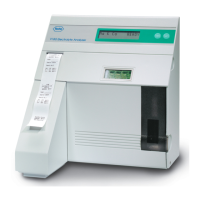Roche Diagnostics
142 Instructions for Use · Version 10.0
9 Maintenance 9180 Electrolyte Analyzer
Unscheduled maintenance
o Disconnect the reference electrode and pull out the white reference electrode
receptacle.
o Disconnect the tubing with the green band from the left side electrode holder.
o Open the sample flap and pull out the fill port.
o Remove the SnapPak and slide out the white SnapPak receptacle. Disconnect the
tubes from the pump winding plate and pull out the tubing harness.
o Re-install the new main harness in reverse order. Use the tubing diagram on the
inside of the front door as a guide for installation. Take care to reconnect the
tubes to the correct nipples of the pump winding.
o Activate each valve by pressing YES. Then, slide the pinch bar on and snap on the
valve cap in the direction of the arrow.
o Press NO to activate the next valve. Note the text on the display.
q
It may be necessary to pull on the metal tip of the valve to put the valve cap into
position.
o Press NO until CALIBRATION? is displayed.
o Press YES to start a calibration.
o After exchanging the main tubing harness, QC measurements on 3 levels have to
be performed to verify the performance of the instrument.
Unscheduled maintenance
WARNING
Inappropriate handling and disposal of used electrodes may cause infection and
environmental harm
Used electrodes may contain liquid and/or solid waste. Inappropriate handling of this
waste during disposal may lead to the transmission of blood or urine borne pathogens. In
addition, inappropriate disposal may contaminate the environment.
r Treat used electrodes as biohazardous waste and dispose it according to the local
regulations. For more information, contact your Roche Service representative.
r Take extra care when working with protective gloves. They can easily be pierced or cut,
leading to infection.
r Wear appropriate personal protective equipment.
r If any biohazardous material is spilled, wipe it up immediately and apply a disinfectant.
r If waste comes into contact with your skin, wash the affected area immediately with
soap and water and apply a disinfectant. Consult a physician.
WARNING
Risk of instrument damage or wrong results due to ESD discharge
Considerable electrostatic discharge can be emitted from contacting the metallic
components of the analyzer.
r Do not remove any cover of the analyzer except those covers specified in the
instructions.
r If it is probable that you will come into contact with metallic components of the
analyzer, touch the discharge point of the analyzer (see Analyzer components (p. 69))
before performing any action on the analyzer.

